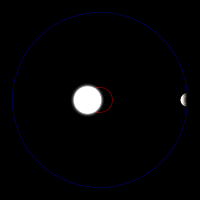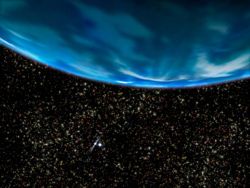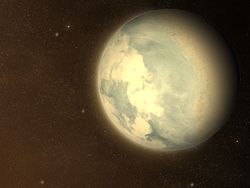Extrasolar planet
2008/9 Schools Wikipedia Selection. Related subjects: Space (Astronomy)
An extrasolar planet, or exoplanet, is a planet beyond the Solar System. As of June 2008, 303 exoplanets have been detected and confirmed. The vast majority were detected through various indirect methods rather than actual imaging. Most of them are massive giant planets likely to resemble Jupiter, though this is likely to be due to limitations in detection technology. Many more recent unconfirmed detections suggest that much smaller worlds may be considerably more common than previous figures have suggested.
Extrasolar planets became a subject of scientific investigation in the mid-19th century. Astronomers generally supposed that some existed, but it was not known how common they were and how similar they were to the planets of the Solar System. The first confirmed detections were made in the 1990s; since 2000, more than 15 have been discovered every year. The frequency of detection is increasing with 61 planets detected in 2007. It is estimated that at least 10% of sun-like stars have planets, and the true proportion may be much higher. The discovery of extrasolar planets sharpens the question of whether some might support extraterrestrial life.
Currently Gliese 581 d, the third planet of the red dwarf star Gliese 581 (approximately 20 light years from Earth), appears to be the best example yet discovered of a possible terrestrial exoplanet which orbits close to the habitable zone of space surrounding its star. Going by strict terms, it appears to reside outside the " Goldilocks Zone", but the greenhouse effect may raise the planet's surface temperature to that which would support liquid water.
History of detection
Retracted discoveries
Unconfirmed until 1988, extrasolar planets have long been assumed as plausible, and speculation on planets circling around the fixed stars dates to at least the early 18th century, with Isaac Newton's General Scholium (1713), which has "And if the fixed Stars are the centers of other like systems, these, being form'd by the like wise counsel, must be all subject to the dominion of One" (trans. Motte 1729).
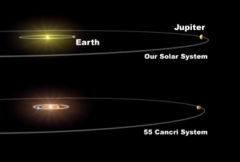
Claims about detection of exoplanets have been made from the 19th century. Some of the earliest involve the binary star 70 Ophiuchi. In 1855, Capt. W. S. Jacob at the East India Company's Madras Observatory reported that orbital anomalies made it "highly probable" that there was a "planetary body" in this system. In the 1890s, Thomas J. J. See of the University of Chicago and the United States Naval Observatory stated that the orbital anomalies proved the existence of a dark body in the 70 Ophiuchi system with a 36-year period around one of the stars. However, Forest Ray Moulton soon published a paper proving that a three-body system with those orbital parameters would be highly unstable. During the 1950s and 1960s, Peter van de Kamp of Swarthmore College made another prominent series of detection claims, this time for planets orbiting Barnard's Star. Astronomers now generally regard all the early reports of detection as erroneous.
In 1991, Andrew Lyne, M. Bailes and S.L. Shemar claimed to have discovered a pulsar planet in orbit around PSR 1829-10, using pulsar timing variations. The claim briefly received intense attention, but Lyne and his team soon retracted it.
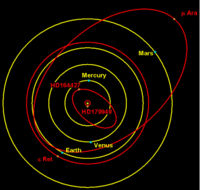
Published discoveries
The first published discovery to have received subsequent confirmation was made in 1988 by the Canadian astronomers Bruce Campbell, G. A. H. Walker, and S. Yang. Their radial-velocity observations suggested that a planet orbited the star Gamma Cephei. They remained cautious about claiming a true planetary detection, and widespread skepticism persisted in the astronomical community for several years about this and other similar observations. It was mainly because the observations were at the very limits of instrumental capabilities at the time. Another source of confusion was that some of the possible planets might instead have been brown dwarfs, objects that are intermediate in mass between planets and stars.
The following year, additional observations were published that supported the reality of the planet orbiting Gamma Cephei, though subsequent work in 1992 raised serious doubts. Finally, in 2003, improved techniques allowed the planet's existence to be confirmed.
In early 1992, radio astronomers Aleksander Wolszczan and Dale Frail announced the discovery of planets around another pulsar, PSR 1257+12. This discovery was quickly confirmed, and is generally considered to be the first definitive detection of exoplanets. These pulsar planets are believed to have formed from the unusual remnants of the supernova that produced the pulsar, in a second round of planet formation, or else to be the remaining rocky cores of gas giants that survived the supernova and then spiraled into their current orbits.
On October 6, 1995, Michel Mayor and Didier Queloz of the University of Geneva announced the first definitive detection of an exoplanet orbiting an ordinary main-sequence star ( 51 Pegasi). This discovery was made at the Observatoire de Haute-Provence and ushered in the modern era of exoplanetary discovery. Technological advances, most notably in high-resolution spectroscopy, led to the detection of many new exoplanets at a rapid rate. These advances allowed astronomers to detect exoplanets indirectly by measuring their gravitational influence on the motion of their parent stars. Several extrasolar planets were eventually also detected by observing the variation in a star's apparent luminosity as a planet passed in front of it.
To date, 303 exoplanets have been found, including a few that were confirmations of controversial claims from the late 1980s. The first system to have more than one planet detected was υ And. Twenty such multiple-planet systems are now known. Among the known exoplanets are four pulsar planets orbiting two separate pulsars. Infrared observations of circumstellar dust disks also suggest the existence of millions of comets in several extrasolar systems.
Detection methods
Planets are extremely faint light sources compared to their parent stars. At visible wavelengths, they usually have less than a millionth of their parent star's brightness. In addition to the intrinsic difficulty of detecting such a faint light source, the parent star causes a glare that washes it out.
For those reasons, current telescopes can only directly image exoplanets under exceptional circumstances. Specifically, it may be possible when the planet is especially large (considerably larger than Jupiter), widely separated from its parent star, and hot so that it emits intense infrared radiation.
The vast majority of known extrasolar planets have been discovered through indirect methods:
- Astrometry: Astrometry consists of precisely measuring a star's position in the sky and observing the ways in which that position changes over time. If the star has a planet, then the gravitational influence of the planet will cause the star itself to move in a tiny circular or elliptical orbit about their common centre of mass (see video on the right).
- Radial velocity or Doppler method: Variations in the speed with which the star moves towards or away from Earth — that is, variations in the radial velocity of the star with respect to Earth — can be deduced from the displacement in the parent star's spectral lines due to the Doppler effect. This has been by far the most productive technique used.
- Pulsar timing: A pulsar (the small, ultradense remnant of a star that has exploded as a supernova) emits radio waves extremely regularly as it rotates. Slight anomalies in the timing of its observed radio pulses can be used to track changes in the pulsar's motion caused by the presence of planets.
- Transit method: If a planet crosses (or transits) in front of its parent star's disk, then the observed brightness of the star drops by a small amount. The amount by which the star dims depends on its size and on the size of the planet.
- Gravitational microlensing: Microlensing occurs when the gravitational field of a star acts like a lens, magnifying the light of a distant background star. Possible planets orbiting the foreground star can cause detectable anomalies in the lensing event light curve.
- Circumstellar disks: Disks of space dust surround many stars, and this dust can be detected because it absorbs ordinary starlight and re-emits it as infrared radiation. Features in dust disks may suggest the presence of planets.
- Eclipsing binary: In an eclipsing double star system, the planet can be detected by finding variability in minima as it goes back and forth. It is the most reliable method for detecting planets in binary star systems.
- Orbital phase: Like the phase of the Moon and Venus, extrasolar planets also have phases. Orbital phases depends on inclination of the orbit. By studying orbital phases scientists can calculate particle sizes in the atmospheres of planets.
- Polarimetry: Stellar light becomes polarized when it interacts with atmospheric molecules, which could be detected with a polarimeter. So far one planet has been studied by this method.
Not counting a few exceptions, all known extrasolar planet candidates have been found using ground-based telescopes. However, many of the methods can yield better results if the observing telescope is located above the restless atmosphere. COROT (launched in December, 2006) is the only active space mission dedicated to extrasolar planet search. Hubble Space Telescope has also found or confirmed a few planets. There are many planned or proposed space missions such as Kepler, New Worlds Mission, Darwin, Space Interferometry Mission, Terrestrial Planet Finder, and PEGASE.
Nomenclature
A lower-case letter is placed after the star name, starting with "b" for the first planet found in the system (for example, 51 Pegasi b). The next planet is labeled, for example, as "51 Pegasi c", the one following that "51 Pegasi d", and so on. The suffix "a" was intended to refer specifically to the primary, as opposed to the system as a whole, but this did not catch on.
Note that the letters assigned are based on the order in which the planets are discovered, and not on their position. For example, in the Gliese 876 system, the most recently discovered planet is referred to as Gliese 876 d, despite the fact that it is closer to the star than Gliese 876 b and Gliese 876 c. Nomenclatures often used in science fiction used Roman numerals in the order of planets' positions from the star, but for the above reason, this is not practical.
Before the discovery of 51 Pegasi b in 1995, extrasolar planets were named differently. The first extrasolar planets found around pulsar PSR 1257+12 were named with capital letters: PSR 1257+12 B and PSR 1257+12 C. When a new, closer-in exoplanet was found around the pulsar, it was named PSR 1257+12 A, not D.
Some of the extrasolar planets have unofficial nicknames, as well. For example, HD 209458 b is sometimes called "Osiris," and 51 Pegasi b is called "Bellerophon." Gliese 581 c, the smallest and most Earth-like planet around main-sequence stars, has been called "Ymir." The IAU currently has no plans to officially name extrasolar planets, considering it impractical.
Definition
According to the International Astronomical Union's working definition of "planet," a planet must orbit a star. However, the current IAU definition for planet only accounts for our own solar system and all extrasolar planets were excluded from this definition for now. There have also been reports of free-floating planetary-mass objects (ones not orbiting any star), sometimes called " rogue planets" or "interstellar planets". Such objects are not discussed in this article since they are outside the working definition of "planet". For more information, see rogue planet.
General properties
Stellar characteristics
Most known exoplanets orbit stars roughly similar to our own Sun, that is, main-sequence stars of spectral categories F, G, or K. One reason is simply that planet search programs have tended to concentrate on such stars. But even after taking this into account, statistical analysis suggests that lower-mass stars (red dwarfs, of spectral category M) are either less likely to have planets or have planets that are themselves of lower mass and hence harder to detect. Recent observations by the Spitzer Space Telescope indicate that stars of spectral category O, which are much hotter than our Sun, produce a photo-evaporation effect that inhibits planetary formation.
Stars are composed mainly of the light elements hydrogen and helium. They also contain a small fraction of heavier elements such as iron, and this fraction is referred to as a star's metallicity. Stars of higher metallicity are much more likely to have planets, and the planets they have tend to be more massive than those of lower-metallicity stars.
In careful spectroscopic observations it is found that rotational velocity drops off abruptly after spectral class F2 stars. It should be noted that the Sun is a G2 Class star (which is, after F2.) Ninety eight percent of the angular momentum of the solar system derives from the orbital motions of the planets. In an isolated system, angular momentum must be conserved, so, of course, the remaining 2 percent lies with the sun. Therefore it seems that the angular momentum of the Sun has been transferred to the planets, that would otherwise cause the Sun to rotate 50 times faster than it currently does (approximately 2 km/sec.) If this hypothesis is correct, slowly rotating stars are so because a large portion of their angular momentum has been transferred elsewhere, perhaps to orbiting planets. Since ninety three percent of all main sequence stars are later than F2, it would seem that the bulk of stars in the galaxy may have planets, unless alternative methods of angular momentum transfer are proven likely.
Measured properties
Most known extrasolar planet candidates have been discovered using indirect methods and therefore only certain physical and orbital parameters can be determined. The radial velocity method provides all orbital elements except for inclination, including orbital period, semi-major axis, eccentricity, angular distance, longitude of periastron, time of periastron, and semi-amplitude. The unknown inclination results in unknown mass and therefore usually only the minimum mass is given. In some cases it may be a much more massive object such as brown dwarf or red dwarf star instead. However, if the planet's orbit is nearly perpendicular to sky ( inclination close to 90°), the planet can be seen transiting its star and therefore its true mass and radius can be measured. Furthermore, astrometric observations and dynamical studies in multiple planet systems can be used to constrain the mass of a planet.
Spectroscopic measurements during the transit can be used to study a transiting planet's atmospheric composition. Secondary transit (occurs when the planet is behind the star) can be used for direct detection of infrared radiation from the planet. In addition, infrared observations can be used to study heat patterns on the surface of a closely-orbiting planet.
Selection effect
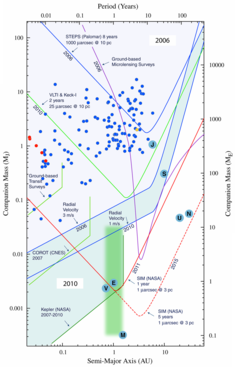
The vast majority of exoplanets found so far have high masses. All but six of them have more than ten times the mass of Earth. Many are considerably more massive than Jupiter, the most massive planet in the Solar System. However, these high masses are in large part due to an observational selection effect: all detection methods are much more likely to discover massive planets. This bias makes statistical analysis difficult, but it appears that lower-mass planets are actually more common than higher-mass ones, at least within a broad mass range that includes all giant planets. In addition, the fact that astronomers have found several planets only a few times more massive than Earth, despite the great difficulty of detecting them, indicates that such planets are fairly common.
Many exoplanets orbit much closer around their parent star than any planet in our own Solar System orbits around the Sun. Again, that is mainly an observational selection effect. The radial-velocity method is most sensitive to planets with such small orbits. Astronomers were initially very surprised by these " hot Jupiters," but it is now clear that most exoplanets (or at least, most high-mass exoplanets) have much larger orbits, some located in habitable zones where suitable for liquid water and life. It appears plausible that in most exoplanetary systems, there are one or two giant planets with orbits comparable in size to those of Jupiter and Saturn in our own Solar System.
The eccentricity of an orbit is a measure of how elliptical (elongated) it is. Most known exoplanets have quite eccentric orbits. This is not an observational selection effect, since a planet can be detected about a star equally well regardless of the eccentricity of its orbit. The prevalence of elliptical orbits is a major puzzle, since current theories of planetary formation strongly suggest planets should form with circular (that is, non-eccentric) orbits. One possible theory is that small companions such as T dwarfs (methane-bearing brown dwarfs) can hide in such solar systems and can cause the orbits of planets to be extreme. This is also an indication that our own Solar System may be unusual, since all of its planets except for Mercury do follow basically circular orbits.
Unanswered questions
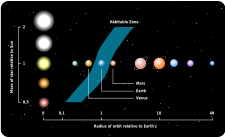
Many unanswered questions remain about the properties of exoplanets, such as the details of their composition and the likelihood of possessing moons. The recent discovery that several surveyed exoplanets lacked water showed that there is still much more to be learned about the properties of exoplanets. Another question is whether they might support life. Several planets do have orbits in their parent star's habitable zone, where it should be possible for Earth-like conditions to prevail. Most of those planets are giant planets more similar to Jupiter than to Earth; if these planets have large moons, the moons might be a more plausible abode of life. Detection of life (other than an advanced civilization) at interstellar distances, however, is a tremendously challenging technical task that will not be feasible for many years, even if such life is commonplace.
Notable extrasolar planets
First discoveries
The first milestone in the discovery of extrasolar planets was in 1992, when Wolszczan and Frail published results in the journal Nature indicating that pulsar planets existed around PSR B1257+12. Wolszczan had discovered the millisecond pulsar in question in 1990 at the Arecibo radio observatory. These were the first exoplanets ever verified, and they are still considered highly unusual in that they orbit a pulsar.
The first verified discovery of an exoplanet ( 51 Pegasi b) orbiting a main sequence star ( 51 Pegasi) was announced by Michel Mayor and Didier Queloz in Nature on October 6, 1995. Astronomers were initially surprised by this "hot Jupiter" but soon set out to find other similar planets with great success.
Other notable discoveries
Since that time, other notable discoveries have included:
- 1996, 47 Ursae Majoris b
- This Jupiter-like planet was the first long-period planet discovered, orbiting at 2.11 AU from the star with the eccentricity of 0.049. There is second companion, initially claimed to orbit some further out, at 3.79 AU. However, the original parameters for the second planet was disproven in 2006, it is now claimed to orbit even further from the star, at 7.73 AU, with the eccentricity of 0.005. Now it is confirmed that this planet orbits at 3.39 AU with the eccentricity of 0.220 ± 0.028 and a period of 2190 ± 460 days.
- 1998, Gliese 876 b
- The first planet found that orbits around a red dwarf star (Gliese 876). It orbits closer to the star than Mercury is to the Sun. More planets have subsequently been discovered closer to the star.
- 1999, Upsilon Andromedae
- The first multiple-planetary system to be discovered around a main sequence star. It contains three planets, all are Jupiter-like. Planets b, c, d are announced in 1996, 1999, and 1999 respectively. Their masses are 0.687, 1.97, and 3.93 MJ; they orbit at 0.0595, 0.830, and 2.54 AU respectively.
- 1999, HD 209458 b
- This exoplanet, originally discovered with the radial-velocity method, became the first exoplanet to be seen transiting its parent star. The transit detection conclusively confirmed the existence of the planets suspected to be responsible for the radial velocity measurements.
- 2001, HD 209458 b
- Astronomers using the Hubble Space Telescope announced that they had detected the atmosphere of HD 209458 b. They found the spectroscopic signature of sodium in the atmosphere, but at a smaller intensity than expected, suggesting that high clouds obscure the lower atmospheric layers.
- 2001, Iota Draconis b
- The first planet discovered around the giant star. It is an orange giant. This provides evidence for a survival and behaviour of planetary systems around giant stars. Giant stars have pulsations that can mimic the presence of planets. The planet is very massive and has a very eccentric orbit. It orbits the average distance of 27.5% further from its star than Earth to the Sun.
- 2003, PSR B1620-26c
- On July 10, using information obtained from the Hubble Space Telescope, a team of scientists led by Steinn Sigurdsson confirmed the oldest extrasolar planet yet. The planet is located in the globular star cluster M4, about 5,600 light years from Earth in the constellation Scorpius. This is the only planet known to orbit around a stellar binary; one of the stars in the binary is a pulsar and the other is a white dwarf. The planet has a mass twice that of Jupiter, and is estimated to be 13 billion years old.
- 2004, Mu Arae d
- In August, a planet orbiting Mu Arae with a mass of approximately 14 times that of the Earth was discovered with the European Southern Observatory's HARPS spectrograph. Depending on its composition, it is the first published "hot Neptune" or "super-Earth".
- 2004, 2M1207 b
- The first planet around a brown dwarf. The planet is also the first to be directly imaged (in infrared). It has 5 Jupiter mass while other estimates give a slightly lower mass. It orbits at 55 AU from the brown dwarf. The brown dwarf mass is only 25 Jupiters. The temperature of gas giant planet is very hot (1250 K), mostly due to gravitational contraction. In late 2005, the parameters changed to 41 AU and has mass of 3.3 Jupiters as a result that the star is closer to Earth than it was originally expected. In 2006, the dust disk was found around 2M1207, providing evidence for a planet formation about the same as typical stars.
- 2005, Gliese 876 d
- In June, a third planet orbiting the red dwarf star Gliese 876 was announced. With a mass estimated at 7.5 times that of Earth, it is currently the second-lightest known exoplanet that orbits an ordinary main-sequence star. It may be rocky in composition. The planet orbits at 0.021 AU with a period of 1.94 days.
- 2005, HD 149026 b
- In July, a planet with the largest core known was announced. The planet, HD 149026 b, orbits the star HD 149026, and has a core that is estimated to be 70 Earth masses, accounting for two-thirds of the planet's mass.

- 2006, OGLE-2005-BLG-390Lb
- On January 25, the discovery of OGLE-2005-BLG-390Lb was announced. This is the most distant and probably the coldest exoplanet found to date. It is believed that it orbits a red dwarf star around 21,500 light years from Earth, towards the centre of the Milky Way galaxy. It was discovered using gravitational microlensing, and is estimated to have a mass of 5.5 times that of Earth, making it the least massive known exoplanet to orbit an ordinary main-sequence star. Prior to this discovery, the few known exoplanets with comparably low masses had only been discovered on orbits very close to their parent stars, but this planet is estimated to have a relatively wide separation of 2.6 AU from its parent star.
- 2006, HD 69830
- A planetary system with three Neptune-mass planets. It is the first triple planetary system around a Sun-like star without any Jupiter-like planets. All three planets were announced on May 18 by Lovis. All three orbit within 1 AU. The planets b, c, d have masses of 10, 12, and 18 Earths respectively. The outermost planet d appears to be in the habitable zone, sheparding the asteroid belt.
- 2007, HD 209458 b and HD 189733 b
- On February 21, 2007, NASA and Nature released news that HD 209458 b and HD 189733 b were the first two extrasolar planets to have their spectra directly observed. This was long seen as the first mechanism by which extrasolar but non-intelligent life forms could be searched for, by way of influence on a planet's atmosphere. A group of investigators led by Dr. Jeremy Richardson of NASA's Goddard Space Flight Centre were first to publication, in the February 22 issue of Nature. Richardson et al. spectrally measured HD 209458 b's atmosphere in the range of 7.5 to 13.2 micrometres. The results defied theoretical expectations in several ways. The spectrum had been predicted to have a peak at 10 micrometres which would have indicated water vapor in the atmosphere, but such a peak was absent, indicating no detectable water vapor. Another, unpredicted peak was observed at 9.65 micrometres, which the investigators attributed to clouds of silicate dust, a phenomenon not previously observed. Another unpredicted peak occurred at 7.78 micrometres, which the investigators did not have an explanation for. A separate team led by Mark Swain of the Jet Propulsion Laboratory also separately analyzed the Richardson team's data and indicated that their findings were similar. They had submitted their results to Astrophysical Journal Letters. A team led by Carl Grillmair of NASA's Spitzer Science Centre made the observations of HD 189733 b, and their results were pending publication in Astrophysical Journal Letters at the time of the news release. On July 11, 2007, the findings by the Spitzer Science Centre were published in the Nature: Spectral imprints of water vapor were found by the Spitzer Space Telescope, thus representing the first solid evidence of water on an extrasolar planet.
- 2007, Gliese 581 c
- Announced on Space.com on April 24, 2007, at 4:23pm ET, it has been determined that this exoplanet could support liquid water and possibly life. While evidence of liquid water has not been detected, the position of this planet—being in a position that might be within the host star's habitable zone—would allow for water to exist in its liquid state. Seth Shostak, a senior astronomer with the SETI institute, stated that on two previous occasions, Gliese 581 was looked at as a potential candidate for extraterrestrial intelligence, but both examinations revealed no proof. The confirmation of the exoplanet's position was determined using the HARPS instrument on the European Southern Observatory's 3.6 meter telescope, by applying the radial velocity detection method. Gliese 581 c is estimated to be fifty percent larger than Earth and close to five times Earth's mass. Some researchers argue that Gliese 581 c will have a runaway greenhouse effect, and thus would not be habitable. They argue, however, that Gliese 581 d is near the outer edge of the Habitable zone.
- 2007, Gliese 436 b
- This planet was one of the first Neptune-mass planet discovered in August 2004. In May 2007, a transit was found, which make it the least massive transiting planet as of yet. Spectral studies found that this planet contains exotic form of solid water called "hot ice," which exists, despite the planet's high temperatures, because the planet's gravity causes water to be extremely dense. Data indicates that it is a rocky and watery planet with a mass 22 times that of Earth.
- 2007, XO-3b
- A 13.24 Jupiter-mass planet is the most massive transiting planet ever found, and most massive extrasolar planet found to date, just above the brown dwarf limit at 13.00 MJ. The planet would have radius of 1.92 times Jupiter, the largest of any known extrasolar planets. The planet takes only 3.19 days to orbit the star. The orbit has an unusually high eccentricity (0.22) for such a short period planet.
- 2007, TrES-4
- The largest-diameter and lowest-density exoplanet to date, TrES-4 is 1.7 times Jupiter's diameter but only 0.84 times its mass, giving it a density of just 0.2 grams per cubic centimeter — about the same as balsa wood. It orbits its primary closely and is therefore quite hot, but stellar heating alone does not appear to explain its large size.
- 2008, OGLE-2006-BLG-109Lb and OGLE-2006-BLG-109Lc
- On February 14 the discovery of the, until now, most similar Jupiter-Saturn planetary system constellation was announced, with the ratios of mass, distance to their star and orbiting time similar to that of Jupiter-Saturn. This can be important for possible life in a solar system as Jupiter and Saturn have a stabilizing effect to the habitable zone by sweeping away large asteroids from the habitable zone.
- 2008, HD 189733 b
- On March 20 follow up studies to the first spectral analyses of an extrasolar planet were published in the scientific journal Nature, announcing evidence of an organic molecule found on an extrasolar planet for the first time. In 2007 water vapor was already detected in the spectrum of HD 189733 b, but new analyses showed not only water vapor, but also methane existing in the atmosphere of the giant gas planet. Although conditions on HD 189733 b are too harsh to harbour life, it still is the first time a key molecule for organic life was found on an extrasolar planet.
- 2008, announcement of 45 new planet candidates
- On May 20, Christophe Lovis of the HARPS team at an international meeting in Boston, Massachusetts announced 45 new planets orbiting around nearby stars, all with masses less than one-tenth Jupiter mass. These were detected by the gravitational tug method using the HARPS located in La Silla, Chile. The discoveries represented a significant increase in the numbers of known super-earths. Astronomers suggest that such low-mass planets may outnumber the Jupiter-like planets by 3 to 1. While the announcement is not yet official (more data are needed to confirm the candidates), some news media picked up the story.
Discovery firsts
| Title | Planet | Star | Year | Notes |
|---|---|---|---|---|
| First planet discovered | PSR B1257+12 B, C | PSR B1257+12 | 1992 | first extrasolar planets discovered
|
| First discovery by a method | ||||
| First planet discovered using the pulsar timing method | PSR B1257+12 B, C | PSR B1257+12 | 1992 | |
| First planet discovered by radial velocity method | 51 Pegasi b | 51 Pegasi | 1995 | |
| First planet discovered by transit method | OGLE-TR-56 b | OGLE-TR-56 | 2002 |
|
| First planet found by gravitational lensing method | OGLE-2003-BLG-235Lb | OGLE-2003-BLG-235L/MOA-2003-BLG-53L | 2004 | |
| First discovery by system type | ||||
| First planet around a solitary star | PSR B1257+12 B, C | PSR B1257+12 | 1992 | first extrasolar planets discovered
|
| First free-floating planet discovered | S Ori 70 | n/a | 2004 | has mass of 3 MJupiter, needs confirmation
|
| First planet in a multiple star system discovered | 55 Cancri b | 55 Cancri | 1996 | 55 Cnc has distant red dwarf companion
|
| First planet orbiting multiple stars discovered | PSR B1620-26c | PSR B1620-26 | 1993 | orbits pulsar - white dwarf pair |
| First multiple planet system discovered | PSR 1257+12 A, B, C | PSR 1257+12 | 1992 | a pulsar planetary system |
| First planet in star cluster | PSR B1620-26c | PSR B1620-26 | 1993 | located in Globular Cluster M4 |
| First discovery by star type | ||||
| First pulsar planet discovered | PSR B1257+12 B, C | PSR B1257+12 | 1992 | |
| First known planet orbiting a Sun-like star | 51 Pegasi b | 51 Pegasi | 1995 | |
| First known planet orbiting a red dwarf | Gliese 876 b | Gliese 876 | 1998 | |
| First known planet orbiting a giant star | Iota Draconis b | Iota Draconis | 2002 | |
| First known planet orbiting a white dwarf (confirmed 2003) | PSR B1620-26c | PSR B1620-26 | 1993 | in December 2007, GD 66 b was discovered orbiting a solitary white dwarf star GD 66 |
| First known planet orbiting a brown dwarf | 2M1207b | 2M1207 | 2004 | first directly imaged planet |
| First free-floating planet discovered | S Ori 70 | n/a | 2004 | has mass of 3 MJupiter, needs confirmation
|
| Firsts by planet type | ||||
| first cool, possibly rocky/icy planet around main-sequence star | OGLE-2005-BLG-390Lb | OGLE-2005-BLG-390L | 2006 | |
| Other firsts | ||||
| First transiting planet | HD 209458 b | HD 209458 | 1999 |
|
| First directly imaged planet | 2M1207b | 2M1207 | 2004 | first planet found around brown dwarf |
